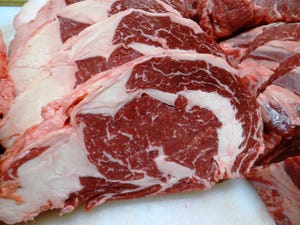Modern Agriculture Is The Solution
Despite oft-repeated claims by sources ranging from the United Nations (UN) to music star Paul McCartney, it’s simply not true that consuming less meat and dairy products
March 29, 2010

Despite oft-repeated claims by sources ranging from the United Nations (UN) to music star Paul McCartney, it’s simply not true that consuming less meat and dairy products will help stop climate change, says a University of California (UC) authority on farming and greenhouse gases (GHGs).
First off, consider the fact that Mom Nature, not man, determines global warming and cooling (see “Fighting the Global Warming Scam” elsewhere in this issue). Next, even if you believed there was a direct cause and effect relationship between GHGs produced by man and global warming, the measures used are flawed.
Frank Mitloehner, UC-Davis associate professor and air quality specialist, says McCartney and the chair of the UN's Intergovernmental Panel on Climate Change ignored science in December when they launched a European campaign called "Less Meat = Less Heat." The launch came on the eve of the major international climate summit in Copenhagen.
McCartney and others, such as the promoters of Meatless Mondays seem to be well-intentioned but not well-schooled in the complex relationships among human activities, animal digestion, food production and atmospheric chemistry, Mitloehner says.
“Producing less meat and milk will only mean more hunger in poor countries,” Mitloehner said. He traces much of the public confusion over meat and milk’s role in climate change to two sentences in a 2006 UN report titled, "Livestock's Long Shadow.” Printed only in the report's executive summary and nowhere in the body of the report, the sentences read: “The livestock sector is a major player, responsible for 18% of GHG emissions measured in CO2e (carbon dioxide equivalents). This is a higher share than transport.”
These statements are not accurate, yet their wide distribution through news media has put us on the wrong path toward solutions, Mitloehner says. “We certainly can reduce our GHG production, but not by consuming less meat and milk. In developing countries, we should adopt more efficient, Western-style farming practices, to make more food with less GHG production,” he explains.
“The developed world's efforts should focus not on reducing meat and milk consumption,” Mitloehner says, “but rather on increasing efficient meat production in developing countries, where growing populations need more nutritious food.”
Mitloehner objects to the UN's statement that livestock account for more GHGs than transportation, when there is no generally accepted global breakdown of gas production by industrial sector.
He notes that “Livestock's Long Shadow” produced its numbers for the livestock sector by adding up emissions from farm to table, including the gases produced by growing animal feed, animals' digestive emissions, and processing meat and milk into foods. But its transportation analysis did not similarly add up emissions from well to wheel; instead, it considered only emissions from fossil fuels burned while driving.
“This lopsided analysis is a classical apples-and-oranges analogy that truly confused the issue," Mitloehner says.
Most of Mitloehner's analysis is presented in a recent study titled, “Clearing the Air: Livestock’s Contributions to Climate Change,” published in October in the peer-reviewed journal Advances in Agronomy. Co-authors of the paper are UC Davis researchers Maurice Piteskey and Kimberly Stackhouse.
See more at airquality.ucdavis.edu/pages.
You May Also Like



